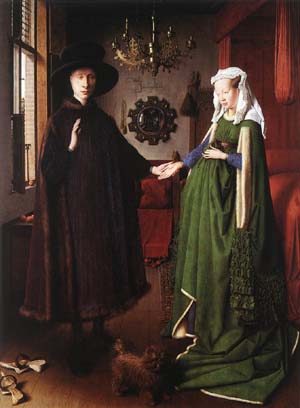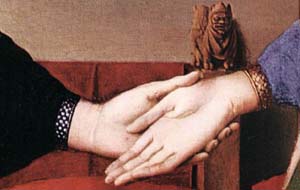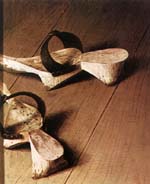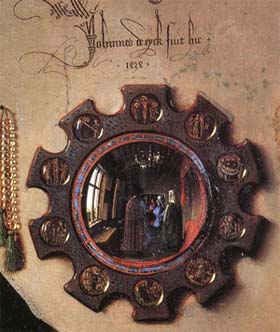| |
And this, precisely, is the reason why the painting carries the title "wedding".
Until the church council of Trient (1545 - 1563), a wedding had not necessarily to take place in church. Neither was the presence of a priest needed, nor were witnesses required. (We'll come back to witnesses later on.)
Matrimony in the Middle Ages was one of the "causae spirituales" thus following canonical law. In cause of disput, a canonical court and eventually the Pope himself would decide.
Only slowly did the clergy succeed in installing this conception of marriage, as opposed to older legal interpretations stemming still from heathen times.
The obligation to fulfil the formalities of today's form of marriage was established by the council of Trient in the 16th century. This is why we find so many clandestine marriages and numerous cases of (deliberate or accidental) bigamy in the Middle Ages.
Before, the act of marriage consisted of two transactions both of which had to be carried out before the marriage became valid: contractio und consummatio. (Now ,I think, is the time to say that nothing further will be said here about the latter, the consummation. Sorry!)
The first, the contract (contractio) is the mutual consent of the marriage partners. Normally, marriages were arranged and women did not have much of a say in the matter.
Here we are talking about the term "matrimonium conscientiae" or even "matrimonium clandestinum". In Germany there exists also the term "Winkelehe" (marriage in a corner). A famous case is the life-story of Agnes Bernauer, who entered into such a "Winkelehe" with the Wittelbachian Duke's son, Albrecht III.
To legally enter into matrimony all one needed to do is shown on this painting:
Not a priest handed out the sacrament, Instead, the two partners gave it to each other, as Hernoult Le Fin does, by taking the hand of his bride and giving promise. The promise is symbolised by the gesture of his raised right hand. This is what matrimonium conscientiae means.
Now, what exactly was the consent and what was its purpose?
Theologians distinguish between "verba pro futuro" of the engagement and "verba de praesenti" of the marriage vows (consentium), by which a marriage was actually established.
At this time, there did not yet exist a public form for the exchange of the "verba de praesenti". A marriage could be clandestinely entered into and without witnesses. In the aftermath, such a union was easy to dissolve, one could just deny that the the legal act had taken place. Later, however, it became common practise to contract a marriage in front of a church so that after the consentiae and the "verba de praesenti" a priest could bless the union, or the couple, after having exchanged the vows in private, went to mass together thus making their marriage public.
Symbol of a ceremony which carries weight before God are the two pairs of shoes in the room. The woman and the man stand, as written in the Old Testament, "on sacred ground". They have therefore taken off their shoes - the moment they make their promise before God renders the very room they stand in a sacred ground.
Normally, it was customary that the bridegroom took the bride's hand with his right hand.
It is not entirely clear whether van Eyck has melted the whole ceremony into one single moment and therefore shown both, oath and handshake simultaneously, which is why the man takes his bride's hand with his left or whether we are witnessing the bond of a morganatic wedding.
|
|
Und genau das ist der Grund warum das Bild Hochzeitsbild genannt wird,.
Bis zum Konzil von Trient (1545 - 1563) musste eine Heirat nicht in der Kirche stattfinden. Es war nicht einmal nötig, daß ein Priester anwesend war oder gar Zeugen. (Wir kommen etwas später noch zu den Zeugen.)
Die Ehe gehört im Mittelalter zu den causae spirituales, die nach kirchlichem Recht geregelt sind, so daß im Streitfall das kirchliche Gericht, d.h. in letzter Instanz der Papst, zu entscheiden hatte.
Allerdings gelang es dem Klerus nur allmählich, diese Auffassung gegenüber älteren, noch aus heidnischer Zeit stammenden Rechtsvorstellungen durchzusetzen.
Die Formpflicht der Eheschließung im heutigen Sinne hat erst das Konzil von Trient im 16. Jahrhundert eingeführt. Deshalb gab es im Mittelalter viele klandestine (heimliche) Ehen und zahlreiche Fälle von (bewußter oder unbewußter) Bigamie.
Die Eheschließung umfaßte zwei Vorgänge, die beide gültig ablaufen mußten: contractio und consummatio. (Es wird vielleicht Zeit zu erwähnen, daß wir hier nicht weiter auf den Begriff der consummatio, des Vollzugs, eingehen.)
Die contractio ist das gegenseitige Einverständnis der Ehepartner.
Normalerweise wurden Ehen arrangiert; Frauen hatten kaum Mitspracherechte.
Wir sprechen hier vom Begriff des matrimonium conscientiae oder gar sogar matrimonium clandestinum. Es existiert dafür auch der deutsche Begriff der Winkelehe. Ein berühmter Fall ist die Geschichte der Agnes Bernauer, die eine eine so genannte Winkelehe mit dem Wittelsbacher Herzogssohn Albrecht III einging.
Um eine legale, gültige Heirat zu schließen, war es nur nötig es so zu machen, wie auf dem Portrait dargestellt:
Nicht der Priester gab das Sakrament, die Partner geben es sich gegenseitig, wie Hernoult le Fin es tut, in dem er die Hand der Braut ergreift und sein Versprechen gibt. Seine erhobene rechte Hand macht dieses Versprechen deutlich. Dies drückt der Begriff matrimonium conscientiae aus.
Was war aber nun der Konsens, und worauf war er gerichtet?
Die Theologen unterscheiden zwischen den "verba pro futuro" der Verlobung und den "verba de praesenti", dem Konsensaustausch oder Jawort, mit dem die Ehe begründet würde.
Es gab noch keine öffentliche Form für den Austausch der "verba de praesenti". Die Ehe konnte heimlich und ohne Zeugen abgeschlossen werden. Die Folge war, daß sie leicht aufzulösen war, man verneinte einfach die Eheschließung. Es wurde aber später üblich, die Ehe vor der Kirche abzuschließen, in der Weise, daß, nach der consentiae und der "verba de praesenti", ein Priester die Vereinigung des Paares segnete, oder daß das Paar nach dem Austausch des Jawortes in privater Zeremonie gemeinsam eine Messe besuchte, um ihre Verbindung öffentlich zu machen.
Als ein Symbol für eine Zeremonie, die ein Gewicht vor Gott hat, gelten die zwei Paar Schuhe in dem Zimmer. Die Frau und der Mann stehen, wie es das alte Testament sagt, "auf geheiligtem Boden". Deshalb haben ihre Schuhe ausgezogen, weil im Moment des Versprechens vor Gott der Raum selbst zum geheiligten Boden wird.
Normalerweise war es üblich, daß der Bräutigam die Hand der Braut mit seiner Rechten ergriff.
Es ist nicht ganz klar, ob van Eyck das Bild so anlegte, daß er die ganze Zeremonie, den Handschlag und das Versprechen, zu einem einzigen Moment verschmolz und deswegen der Mann die Hand seiner Braut mit seiner linken Hand greift, oder ob wir Zeuge einer morganatischen Ehe, einer Ehe linker Hand, werden.
|
|




